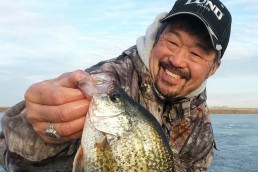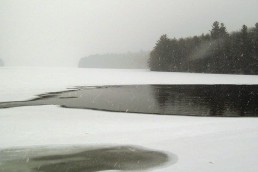Close to Spawning Areas for Late-ice Reservoir Crappies
SHARE THIS POST
Late ice might be one of the best periods of winter for finding crappies on predictable patterns. These locations can vary from reservoirs to ponds to natural lakes, but the starting point typically points to structure adjacent to shallow bays or tributary arms where crappies spawn each spring.
Much of what is written about ice-crappie patterns is noted with natural lakes in mind. Much of the information is pertinent to natural lakes, and is most relevant to anglers in Minnesota and Wisconsin where Northwoods lakes typically offer deep water combined with structure, weedlines and shallow, spawning habitat. Several other patterns can emerge on different lake types, rivers and reservoirs, but what all of these do share is a common thread or theme in regard to productive locations for crappies at late ice.
The best locations are simply some type of structure or cover adjacent to the known spring spawning locations. Focus on obvious structure that connects the primary lake, river or reservoir with the shallow spring marsh habitat that holds black spawning crappies in the spring.
Not surprisingly, brush piles in deeper water near these shallow spawning locations are crappie magnets. Large reservoirs like the upper end of Lake Oahe have turned heads in recent years for producing solid crappie fishing at late ice, and the program is pretty simple: find flooded brush or trees that coincide with the old creek channels from the incoming tributaries like Beaver, Porcupine or Pollock bays. As late ice progresses, fish typically push farther up into the creek arms as the ice goes out. These brush-pile patterns also shine on flowages in northern Wisconsin, the Mississippi River backwaters and other reservoirs.
Obviously, brush piles and flooded trees hold crappies, but how do you find these underwater crappie magnets? Fortunately, there are several ways for scouting and locating fish. On some bodies of water, trees can be found and pinpointed by using older aerial photo imagery from when the lake or reservoir was low. In some cases, this imagery can be found on map chips for some bodies of water. Sonar, or in some cases, underwater cameras, can be used to pinpoint wood. The fastest, most efficient way to find these locations is to run through these areas during summer with side imaging and save waypoints for ice time.
Are you enjoying this post?
You can be among the first to get the latest info on where to go, what to use and how to use it!
The complex brush piles and stumps that provide the most cover often have the potential to hold the most fish. While there are exceptions, most reservoirs that boast good populations of crappies also hold some flooded trees and brush. The populations here are often cyclic, ebbing up and down as a result of water levels. Typically, low-water years allow brush and trees to grow along the shoreline while high-water years flood.
So often on these late-ice patterns on reservoirs, flowages and river systems where flooded brush and wood can be such a crucial factor for locating them, and ice anglers often have to fish in current. On many reservoirs, this current will ebb and flow, where it will pick up for an hour then disappear and be sporadic. The bite will often coincide with these pulses of current right as it lets down or just begins to pick up. We see this current phenomena on big reservoirs like Lake Oahe, but many other flowages and river systems have some type of current too.
Because of the combination of current and wood, we typically use larger lures than what many ice anglers associate with crappies. Late ice often sees these fish more aggressive and these larger profiles fish better in current and are capable of calling them out of the wood. Remember, the key to searching wood is with a presentation so that you can either lift a fish out of the brush by fishing above it and getting it to chase or by dropping through the branches and pulling the fish in from the vicinity. Small rattle baits and jigging spoons like the Clam Rattling Blade Spoon really shine in this particular environment. Of course, classic tungsten jigs combined with soft plastics are still effective, but don’t be afraid to increase the size dramatically and experiment with presentations that rattle. As a rule, we catch more fish in these types of environments with a lure that has extra noise from rattles. Remember a fish’s range of vision is limited in flooded brush and timber so you need to be able to reach these with noise. Typically, we’ll start out with rattle lures and then drop back to traditional tungsten jigs tipped with baits or soft plastics if the bite is off.
Because of the snags and challenges of fishing in wood, don’t be afraid to use a light braided line in either 4- or 6-pound-test. Braid isn’t popular in a lot of ice fishing circles, but this is a situation where it can be much more effective than mono. Typically, these brush-pile fish “dunk” the rod tip when they’re hit. Particularly when you lift the fish out of brush up to your presentation is when they’ll “slam” it.
There are many reservoirs that can be difficult to fish throughout much of the winter, as crappies are scattered and unpredictable. But then late-ice patterns kick in where anglers can target these fish on purpose. On many fisheries, these patterns have serious big-fish potential. Most of these lack weed growth and don’t have the classic green weed patterns that typify what’s often said about late-ice crappies. But what also makes the reservoir and flowage patterns somewhat different is that these can sometimes occur in fairly deep water right up until the very end. While it’s possible to find some of these reservoir fish holding right under the ice and up in really shallow water, these, as a general rule of thumb, seem much more structure-orientated. Channel cuts, points, and inside turns typically created by submerged creek channels, hold these fish. These areas are typically better if there is any flooded wood or brush present. These are particularly in the Dakotas and Nebraska, where late-ice reservoir patterns produce some of the best big-fish opportunities each winter.
MWO
SHARE THIS POST
Did you enjoy this post?
You can be among the first to get the latest info on where to go, what to use and how to use it!
Jason Mitchell
Jason Mitchell was a top walleye guide on Devils Lake, N.D. for nearly 20 years. Today, Mitchell produces the Jason Mitchell Outdoors TV program. Visit jasonmitchelloutdoors.com for more.



